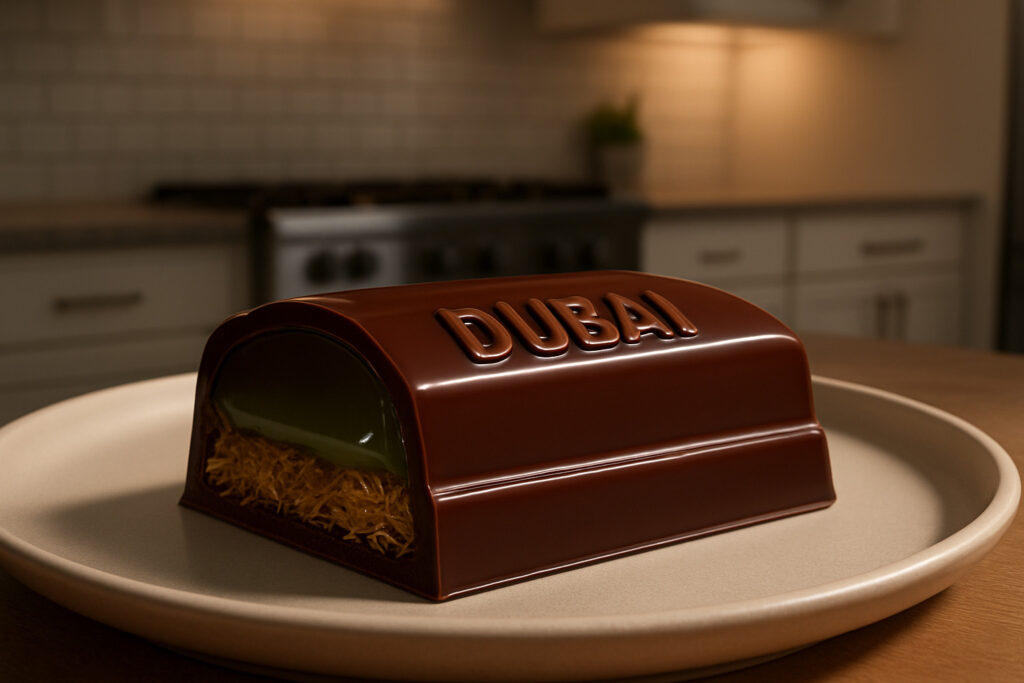The Viral Dubai Chocolate Bar: A Luxurious DIY Treat
The dubai chocolate bar recipe is a decadent treat featuring a chocolate shell filled with crispy toasted kataifi pastry and creamy pistachio filling. This viral sensation from Dubai can be made at home in about 1 hour with these key components:
- Shell: High-quality dark or milk chocolate (tempered for best results)
- Filling: Pistachio cream mixed with tahini and toasted kataifi pastry
- Optional: Decorative colored chocolate drizzle
The Dubai chocolate bar went viral in late 2023 after being created by Fix Dessert Chocolatier in Dubai, where it retails for a whopping $25 per bar. The combination of Middle Eastern flavors with Western chocolate techniques created a dessert sensation that food lovers worldwide are now recreating at home.
“Sometimes viral items aren’t worth the hype and sometimes they are — this Dubai chocolate bar is absolutely worth it,” notes food blogger Lorraine Elliott, whose recipe has been rated 5 out of 5 by over 113 readers.
What makes this chocolate bar special is the unexpected textural contrast between the smooth chocolate exterior, the creamy pistachio filling, and the satisfying crunch of toasted kataifi (shredded phyllo dough). The bar was actually inspired by knafeh, a traditional Middle Eastern dessert, but reimagined in chocolate bar form.
The good news? While the original may cost $25, you can make two large bars or about 16-20 bite-sized servings at home for a fraction of the cost.

What Made the Dubai Chocolate Bar Go Viral?
The dubai chocolate bar recipe catapulted into social media stardom in late 2023, with videos showing that satisfying moment of breaking into the glossy shell to reveal its nutty, crispy interior. These clips racked up millions of views across TikTok and Instagram, leaving viewers worldwide craving a taste of this luxurious treat.
Fix Dessert Chocolatier in Dubai, UAE deserves credit for the original creation that started it all. What made this chocolate bar stand out wasn’t just its beautiful appearance—it was the perfect harmony of sensations: the clean snap of well-tempered chocolate giving way to velvety pistachio cream studded with delightfully crisp strands of buttery toasted kataifi.
The hefty $25 price tag per bar didn’t deter chocolate lovers. If anything, it improved the mystique, positioning it as a premium dessert experience worth splurging on.
| Feature | Original Dubai Chocolate Bar | Homemade Version |
|---|---|---|
| Price | $25 per bar | About $5-7 per bar |
| Size | 100g | Customizable (typically 2 large bars from recipe) |
| Ingredients | Premium chocolate, pistachio cream, kataifi | Same, but you control quality |
| Shelf life | Unknown | Up to 3 weeks refrigerated |
The Story Behind the Craze
The dubai chocolate bar recipe has roots in a relatable craving story. Chocolatier Sarah Hamouda reportedly created it during her pregnancy when she was longing for knafeh— that beloved Middle Eastern dessert made with shredded phyllo dough, sweet cheese, and fragrant syrup. If you’re unfamiliar with knafeh, you can read more about its history and variations on its Wikipedia page. When she couldn’t find knafeh that hit the spot, she brilliantly re-imagined its elements in chocolate bar form.
This clever fusion perfectly represents Dubai’s vibrant food scene, where traditional Middle Eastern flavors often dance with global culinary techniques. The city has blossomed into a luxury food destination, and this chocolate bar embodies that cosmopolitan spirit in each bite.
Why This Flavor-Texture Combo Works
From a food science perspective, the dubai chocolate bar recipe isn’t just a passing trend—it’s a textbook example of culinary genius that delights multiple senses simultaneously.
When kataifi pastry toasts in butter, it undergoes the Maillard reaction—that magical chemical process that creates hundreds of new flavor compounds. This scientific phenomenon gives the kataifi its irresistible nutty, caramelized notes that complement the pistachio cream perfectly.
The chocolate shell’s satisfying snap comes from properly tempered cocoa butter crystals forming a precise molecular structure. This crisp exterior creates an exciting contrast with the creamy filling, stimulating different sensory receptors with each bite.
Ingredients & Equipment Guide for dubai chocolate bar recipe
Ready to recreate that luxurious viral sensation in your own kitchen? Let’s gather everything you’ll need for the perfect dubai chocolate bar recipe. Trust me, while the ingredient list might look fancy, most items are more accessible than you’d think!
Key Ingredients:
The magic of this dessert comes from its unique combination of textures and flavors. You’ll need about 1⅔ cups (100g) of kataifi pastry – those delicate shredded phyllo strands that provide that distinctive crunch we all love. For the creamy element, ¾ cup (190g) of pistachio cream forms the heart of your filling, while 3 tablespoons of tahini adds that subtle Middle Eastern depth that makes this treat so special.
Don’t skimp on the chocolate – you’ll need about 2 cups (400g) of high-quality dark or milk chocolate. Chocolate chips contain stabilizers that affect melting, so opt for chocolate bars instead. A few tablespoons of butter for toasting the kataifi and a pinch of sea salt to improve all those wonderful flavors rounds out your ingredient list.

Your kitchen arsenal should include deep chocolate bar molds (silicone works wonderfully for easy unmolding), a candy thermometer for perfect tempering, and an offset spatula for those smooth, professional finishes. You’ll also need a double boiler or microwave-safe bowl for melting chocolate, a frying pan with high sides to toast the kataifi without making a mess, and various mixing bowls for preparation.
Pistachio Cream vs Paste vs Butter
I can’t tell you how many home bakers get confused about this part of the dubai chocolate bar recipe! Let me clear things up:
Pistachio cream is your best bet here – it’s essentially pistachio paste that’s been sweetened and often contains milk powder and sometimes oil. It has a smoother, sweeter profile and typically appears lighter green. This is what gives the authentic Dubai bar its perfect sweetness level and creamy texture.
Pistachio paste, on the other hand, is simply 100% pistachios ground to a smooth consistency. It’s unsweetened with a more intense, almost savory pistachio punch. You can use it, but you’ll need to add your own sweetener to balance the flavor.
Pistachio butter sits somewhere between the two – similar to paste but sometimes containing added oil for a silkier feel. Like paste, it’s typically unsweetened.
For more information about the differences between these pistachio products and their culinary applications, check out this comprehensive guide from The Spruce Eats.
Where to Find Specialty Items
For kataifi pastry, check the frozen section of Middle Eastern or Mediterranean grocery stores. International food markets often carry it too. In a pinch, very finely shredded phyllo dough can work, or even toasted shredded coconut for a different but delicious twist.
Pistachio cream hides in specialty food stores, Italian or Middle Eastern markets. Can’t find it? Make your own by blending roasted pistachios with sugar, a little oil, and milk powder until silky smooth.
Those pretty chocolate bar molds are available at baking supply stores and craft shops with baking sections. Don’t have molds? Silicone ice cube trays work surprisingly well, or try mini loaf pans for a different shape.
Step-by-Step dubai chocolate bar recipe: Fool-Proof Method
Ready to create this viral sensation in your own kitchen? Let’s break down the dubai chocolate bar recipe into manageable steps that even novice chocolatiers can master.

1. Toast & Cool the Kataifi
Start by gently separating your kataifi strands with your fingers – this prevents clumping and ensures even toasting. In a large pan with high sides, melt 2-3 tablespoons of butter over medium heat until it’s just bubbling.
Add your separated kataifi to the pan and stir continuously for about 8-10 minutes until it reaches a perfect golden brown color. Once done, transfer it to a paper-towel lined plate and let it cool completely.
2. Blend the Pistachio Filling
In a medium bowl, combine ¾ cup of pistachio cream with 3 tablespoons of tahini. The tahini adds a subtle depth that balances the sweetness perfectly. Don’t forget a pinch of salt – it’s small but mighty in enhancing the pistachio flavor.
Stir until you have a silky-smooth mixture with no streaks of tahini visible. Now gently fold in your cooled kataifi. The ideal consistency should be spreadable but not runny. If yours seems too thick, a touch more tahini will loosen it up. Too runny? A couple tablespoons of melted white chocolate works wonders as a thickening agent.
3. Temper the Chocolate Like a Pro
For the seed method, start by finely chopping 2 cups of high-quality chocolate. Set aside about a quarter of it as your “seed” chocolate. Melt the remaining chocolate in a double boiler or microwave until it reaches 113-120°F for dark chocolate or 105-110°F for milk chocolate.
Remove from heat and add your reserved chocolate, stirring continuously until all pieces melt and the temperature drops to 88-90°F for dark or 86-88°F for milk chocolate. To test if your chocolate is properly tempered, dip a knife tip in it and let it sit for 3-5 minutes – properly tempered chocolate will set with a beautiful shine.
For more detailed information on chocolate tempering techniques, check out this excellent guide from Serious Eats.
4. Mold, Fill, Seal
Pour about 1-2 tablespoons of your tempered chocolate into each mold cavity. Using a pastry brush or the back of a spoon, coat the sides and bottom evenly, making sure your shell is about 1/8 inch thick.
Give your mold a few gentle taps against the counter to release any air bubbles, then place it in the refrigerator for 15-20 minutes until the chocolate is set but not fully hardened.
When you remove the mold, fill each cavity about ¾ full with your pistachio-kataifi mixture, being careful to leave space for the bottom chocolate layer. Cover completely with more tempered chocolate, using an offset spatula to create a smooth surface. Give it another gentle tap to remove air pockets and ensure the chocolate seals all gaps.
5. Unmold & Decorate
After chilling your bars for 30-60 minutes, it’s time for the big reveal. Look for slight shrinkage from the edges of the mold – that’s your signal that the chocolate is fully set.
For silicone molds, gently flex the sides and push from the bottom to release the bars. Using hard plastic molds? Turn them upside down and tap gently until gravity works its magic.
Consider drizzling contrasting chocolate across the top, sprinkling with crushed pistachios, or adding a light dusting of edible gold dust for that luxury touch. Before serving, let the bars sit at room temperature for 5-10 minutes to allow the flavors to fully develop.
Troubleshooting, Variations & Storage
Even the most careful bakers can hit a snag when making the dubai chocolate bar recipe. Here are solutions for common issues and creative variations to try.
Common Troubleshooting Issues:
That white, cloudy appearance on your chocolate? That’s bloom—perfectly safe to eat but not the prettiest. It happens when chocolate hasn’t been tempered correctly or experiences temperature swings. The fix is simple: just remelt and properly temper again for that gorgeous shine.
If your pistachio filling seems too loose to work with, add a couple tablespoons of melted white chocolate and give it a brief chill in the refrigerator for a more workable consistency.
Thin shells are the nemesis of beautiful chocolate bars—they crack easily and ruin your hard work. Make sure your initial chocolate layer is about 1/8 inch thick and completely set before adding your filling.
Creative Flavor Variations:
The beauty of the dubai chocolate bar recipe is how versatile it is. Once you’ve mastered the original, try these delicious variations:
For those who prefer less sweetness, try a Dark Chocolate Tahini version. The bittersweet notes of 70% dark chocolate paired with extra tahini create a sophisticated flavor profile that coffee lovers particularly appreciate.
Got a jar of Biscoff spread in your pantry? The Biscoff Twist variation swaps half the pistachio cream for this spiced cookie butter, creating a warm, caramel-like note that’s absolutely divine with the crunchy kataifi.
When we hosted our Middle Eastern dessert night, the Rosewater Pistachio variation was the first to disappear. Just a few drops of rosewater in the filling creates an aromatic experience that transports you straight to a Damascus sweet shop.
For a truly Instagram-worthy creation, try a Ruby Chocolate Shell. The naturally pink chocolate has berry-like notes that create a fascinating contrast with the nutty pistachio filling.
For more creative chocolate dessert ideas and techniques, visit Taste of Home’s chocolate dessert collection.
Shelf-Life & Best Storage Practices
For properly tempered chocolate, an airtight container at cool room temperature (below 70°F/21°C) works beautifully for up to 3 weeks. This storage method preserves that satisfying snap when you bite into the bar.
In warmer weather, refrigeration is your friend. Store bars in an airtight container for up to 3 weeks, but remember to let them come to room temperature for 10-15 minutes before serving. Cold chocolate doesn’t release its flavors as readily as room-temperature chocolate.
Planning ahead? These bars freeze remarkably well. Wrap each one in parchment paper, then place in an airtight container or freezer bag for up to 3 months. Thaw overnight in the refrigerator, then bring to room temperature before enjoying.
Frequently Asked Questions about Dubai Chocolate Bars
What’s the difference between pistachio cream and pistachio paste?
One of the most common questions about the dubai chocolate bar recipe concerns the pistachio ingredients. Pistachio cream is sweetened and has a smoother consistency, typically containing sugar, milk powder, and sometimes oil along with the pistachios. This creates that perfect sweet, nutty flavor that makes the Dubai chocolate bar so irresistible.
Pistachio paste, however, is simply pistachios ground into a smooth consistency without any additives. While you can certainly use paste in your homemade version, you’ll need to add some powdered sugar to achieve the right sweetness. The cream version saves you this extra step and generally produces a more authentic result.
Can I make the bars without special molds or tempering chocolate?
Don’t let special equipment stop you from trying this dubai chocolate bar recipe! While traditional molds create that classic bar shape, you can easily create a “bark” version that’s just as delicious. Simply spread a layer of chocolate on a parchment-lined baking sheet, chill it until almost set (about 10 minutes), then spread your pistachio-kataifi filling on top, leaving a small border. Cover with another layer of chocolate, chill until set, and break into rustic pieces.
For those without tempering equipment, add about 1 tablespoon of coconut oil per cup of chocolate when melting. While not technically tempered, this helps prevent that whitish bloom when refrigerated.
Another approachable option is using silicone cupcake liners to create “cups” instead of bars. These are much easier to unmold and provide perfect individual portions.
How many calories are in a homemade bar?
A standard-sized bar (approximately 100g) contains about 500-600 calories, with roughly 40-45g of fat (primarily from the chocolate and nuts), 40-50g of carbohydrates (including 30-35g of sugar), and 8-10g of protein.
If you’re making bite-sized portions (about 25g each), each piece would contain approximately 125-150 calories. Not bad for such a luxurious treat!
For more information about the nutritional aspects of chocolate and its health benefits when consumed in moderation, check out Harvard T.H. Chan School of Public Health’s article on chocolate.

Conclusion
The dubai chocolate bar recipe truly represents the best of both worlds – the aromatic spices and textures of Middle Eastern desserts wrapped in the familiar comfort of chocolate. What started as a $25 luxury treat in Dubai has transformed into something we can all create in our own kitchens, with just a bit of patience and the right ingredients.
There’s something incredibly satisfying about making these bars yourself. Not only do you save significantly (creating about 16-20 servings for roughly the same cost as a single original bar), but you also gain complete creative control. Want it less sweet? More tahini? A hint of cardamom? The kitchen is your playground.
At The Dining Destination, we’ve always believed that food is one of the most powerful ways to travel without a passport. This Dubai chocolate bar perfectly demonstrates how culinary traditions can cross borders and evolve into something entirely new and exciting.
These homemade chocolate bars make wonderful gifts, too. Wrapped in gold foil or tucked into small boxes, they offer a personal touch that store-bought treats simply can’t match. Your friends might not believe you made something so professional-looking until they taste the freshness that only homemade can deliver.
What makes this dessert truly special is its multi-sensory experience. The sharp snap of well-tempered chocolate gives way to creamy pistachio filling, punctuated by the delicate crunch of toasted kataifi. It’s this combination of textures and flavors that explains why this treat captured the world’s imagination.
We’d love to see your creations if you try this recipe! And remember, the next time you’re planning a trip to Dubai or exploring other culinary hotspots, The Dining Destination is your go-to resource for finding the next viral food sensation before it floods your social media feed.








